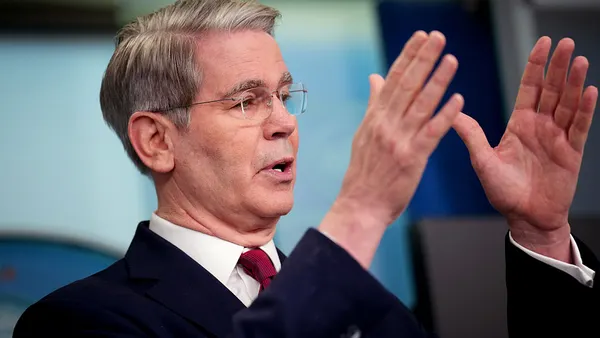Dive Brief:
- U.S. factory output sagged in August for the sixth consecutive month as prices rose and employment, supplier deliveries and raw materials inventories waned, the Institute for Supply Management said Tuesday
- Despite signs of weakness, an index of new orders increased last month as the Trump administration announced trade deals with several countries, nudging up an ISM composite manufacturing index to 48.7% from 48% in July.
- “Since production contracted at a rate nearly equal to the expansion in new orders, the manufacturing PMI [purchasing managers index] increase was nominal,” Susan Spence, chair of the ISM Manufacturing Business Survey Committee, said in a statement. “The employment index edged up slightly, as panelists indicated that managing head counts is still the norm at their companies, as opposed to hiring.”
Dive Insight:
The ISM survey results added to evidence that the Federal Reserve may face a stark dilemma at a meeting to consider changes to monetary policy on Sept. 16-17.
With the labor market weakening and inflation persisting well above the Fed’s 2% long-run goal, policymakers need to decide whether to trim the main interest rate and risk stoking price pressures or leave rates unchanged despite signs of increasing risks to employment.
An index of prices paid by manufacturers for raw materials, while easing 1.1 percentage points last month to 63.7%, remained at a level indicating costs are rising, Spence said.
A broader measure of inflation showed that price pressures persist well above the Fed’s target. The personal consumption expenditures price index excluding volatile food and energy prices — the central bank’s preferred inflation gauge — rose at a 2.9% annual rate in July, the Bureau of Economic Analysis said Friday.
Consumers see a grimmer outlook for prices. Their expectations for inflation in a year increased to 4.8% last month from 4.5% in July, according to a University of Michigan survey released Friday.
Meanwhile, the ISM’s employment index inched up 0.4 percentage point to 43.8% but remained at a weak, post-pandemic level, aligning with other signs of a cooling labor market.
For example, U.S. payrolls grew at only an average monthly rate of 35,000 from May through July, slowing from a 168,000 monthly pace in 2024.
“Labor demand may be on the edge of a sharp decline,” Fed Governor Christopher Waller said Thursday, noting that wage growth for workers switching jobs is lower than for those staying at the same jobs.
Also, unemployment for teenagers and other “cyclically sensitive” groups have surged this year to levels similar to those during the soft job market in the mid-2010s, Waller said.
“Supplementing this hard evidence of falling labor demand is the consistent story from my business contacts that they are not hiring,” he said.
“While there are signs of a weakening labor market, I worry that conditions could deteriorate further and quite rapidly,” Waller said, calling for a quarter-point reduction to the federal funds rate at the policy meeting this month.
“It is important that the Federal Open Market Committee not wait until such a deterioration is underway and risk falling behind the curve is setting appropriate monetary policy,” he said, adding that additional cuts to borrowing costs may be needed before the end of the year.
Waller and one other Fed governor dissented against an FOMC vote in July to hold the main rate steady, calling for a quarter-point reduction from the current level between 4.25% and 4.5%.











